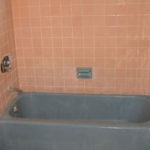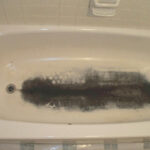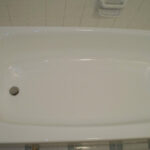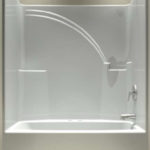BATHTUB REFINISHING
Bathtub refinishing is known by many names: bathtub resurfacing, bathtub re-glazing, bathtub refurbishing, even bathtub re-enameling. No matter the term used, bathtub refinishing is simply a "sprayed-on" process that makes a worn out, damaged bathtub look like new again.
This like-new appearance cannot be achieved with Do-It-Yourself products. Only a professional refinisher has access to the high-tech, durable coatings that are required to give a bathtub its shiny new appearance. More importantly, only a seasoned, professional refinisher has the tools and skill to apply the surface correctly.
A tell-tale sign that it's time to refinish a porcelain tub is when it's getting hard to clean - or hard to keep clean - and it never really looks clean no matter what you do. This is a sign that the porcelain finish is wearing off (usually on the bottom, but sometimes on the sides, too). How does that happen? The finish wears off over time due to cleaning with harsh abrasives, which can cause a porcelain surface to become so porous that soap and body oils collect easily on the surface, making it nearly impossible to look clean, even when you know it is.
Types of Bathtubs
Bathtubs can be made of 3 different types of materials - porcelain, acrylic, and fiberglass. The base for a porcelain bathtub is metal - either steel or cast iron - and the porcelain on top is baked on during the manufacturing process. Acrylic and Fiberglass are flexible, man-made materials.
Porcelain bathtubs are the most common type found in homes built before the 1970s. A "standard" size tub is about 5 feet in length and in the shape of a rectangle. Acrylic and Fiberglass bathtubs can be either standard size, or part of a wall unit where the tub and the surrounding walls are one piece.
To get a bid quickly, send one image of the entire tub, to include what's behind it, above it, beside it, and above it (there will be no detail in this image). Just walk into the bathroom and take an overall, broad picture of the entire area so I can see how the tub is sitting in the room. Also send images of any damage you can see.
Bathtubs with Tiled Surrounds
Porcelain tubs set in an alcove are generally surrounded by three (3) walls of tile. Refinishing is recommended for wall tile under these scenarios:
-
The tile walls do not look clean anymore, even when you know they are.
-
The wall tile is the wrong color.
-
You want to seal the grout lines to deter water from getting behind the tile and causing damage.
 Before considering refinishing wall tile, you need to ensure the wall behind the tile is still in good shape. To do this, gently push on any tiles that are discolored, loose, or have missing grout. If they feel soft or "spongy," it could indicate water damage behind the tile that needs to be addressed. Refinishing is not an option until you know that the walls behind the tile are solid.
Before considering refinishing wall tile, you need to ensure the wall behind the tile is still in good shape. To do this, gently push on any tiles that are discolored, loose, or have missing grout. If they feel soft or "spongy," it could indicate water damage behind the tile that needs to be addressed. Refinishing is not an option until you know that the walls behind the tile are solid.
If you already know that the walls behind the tile are solid, we can get you an accurate bid for refinishing the tiled surround if you send us a measurement for the height of the tiled wall, measured from the top of the tub to the top of the tile.
Refinishing vs. Deep Cleaning - which do you really need? If the color of your tile is the old vintage look of pink, green yellow, or even blue, and you simply want to change the color, refinishing is what you want. However, if you like the color the way it is, but the tile looks old, tired, or extremely dirty, especially around the grout lines, it may not necessarily mean that the tile needs to be refinished. The tiles may only need a really deep clean, so ask us about this option! We can deep clean the tiles to make the entire surround look really clean again (this is not an ordinary type of clean that you can or would do). The cost to deep clean a standard 50sf surround (3 walls of tile that are 5 feet high) is $250.
One-Piece Bathtub Wall Units
As mentioned above, standard size Acrylic and Fiberglass bathtubs can also be part of a one-piece wall unit where the tub and the surrounding walls are all one piece.
How can you tell if your bathtub is a wall unit and not a "stand-alone" tub? Look for a caulk line that clearly separates the bathtub from the walls surrounding it. If there is no caulk line, then yours is a 1-piece wall unit.
Unfortunately, this means that even though only the tub may need refinishing, the entire unit must be refinished - again, because it is one molded piece of material.
To get you an accurate bid for this type of unit, we need a measurement for the height of the wall, measured from the top of the tub to the top of the unit.
Repair Work Prior to Refinishing
If there is damage in a bathtub, all of it must be repaired before the bathtub can be refinished. Please be aware that some porcelain bathtubs are manufactured with anti-slip bottoms that have been sandblasted into the porcelain finish. Because of that, the section of the sandblasted porcelain develops pinholes, pock marks, and dimples that may or may not be seen with the naked eye.
However, once we start to spray on the new finish, these flawed areas begin to appear. To help reduce this problem prior to refinishing, we fill in these flawed areas with Bondo to build them up, then gently sand them smooth as part of the prep phase. We call this process "skinning" the tub, and it is part of the repair process.
Please note that our warranty is specifically related to the two things under our control: workmanship and product defects. We do not guarantee that rust, cracks, or holes won't reappear later in a bathtub if the underlying source of the damage (possibly a house shift, improper initial installation, water leak, or previous damage to the same area) has not been corrected.
PRICING
When a tub is refinished properly, repairs are never an option. They must be done - not only to achieve a beautiful end result, but also to guarantee the work! Our prices include all prep, standard repairs, and refinishing, as well as a Turnkey service, which means coming back the next day to (1) remove the paper and plastic on the floor and walls that served to protect those areas from overspray, (2) re-caulk around the bathtub where necessary, and (3) re-install the drain and overflow cover when necessary. The cost for this, if the property is located within our normal travel range, is generally $750 for standard size porcelain bathtubs.
For standard size fiberglass and acrylic bathtubs, the cost starts at $750 and goes up, depending on the repairs needed. Due to cracks in fiberglass and acrylic tubs, most repairs are much more extensive than porcelain repairs. In addition to that, these types of repairs cannot be guaranteed due to the underlying cause of the damage being unidentified and unresolved.
If a tub has been refinished before, the existing coating must be stripped back down to the original porcelain finish. The cost for this service is an additional $175, which brings the total cost to $925 for stripping, repairing, and refinishing a tub, turnkey.
Service Areas
Our service areas extend to most of the Dallas Fort Worth metroplex. Jim's home base is Colleyville, so he generally services the cities of Argyle, Bedford, Carrollton,  Colleyville, Coppell, Euless, Flower Mound, Fort Worth, Grapevine, Haltom City, Haslet, Hurst, Justin, Keller, Lewisville, Northlake, North Richland Hills, Richland Hills, Roanoke, Saginaw, Southlake, Trophy Club, Watauga, and Westlake.
Colleyville, Coppell, Euless, Flower Mound, Fort Worth, Grapevine, Haltom City, Haslet, Hurst, Justin, Keller, Lewisville, Northlake, North Richland Hills, Richland Hills, Roanoke, Saginaw, Southlake, Trophy Club, Watauga, and Westlake.
David's home base is Dallas, so he generally services the cities of Arlington, Cedar Hill, Dallas, DeSoto, Duncanville, Farmers Branch, Garland, Grand Prairie, Hutchins, Irving, Lancaster, Mesquite, Plano, Richardson, and Rowlett. These cities indicate our maximum travel range. Outside of these areas an additional travel charge would apply, or if Jim and David crossed areas.
Call Debbie at 817.305.0300 or email [email protected] if you're unsure whether we travel to your area without an additional travel charge, which generally ranges from $25-$50 per day.




